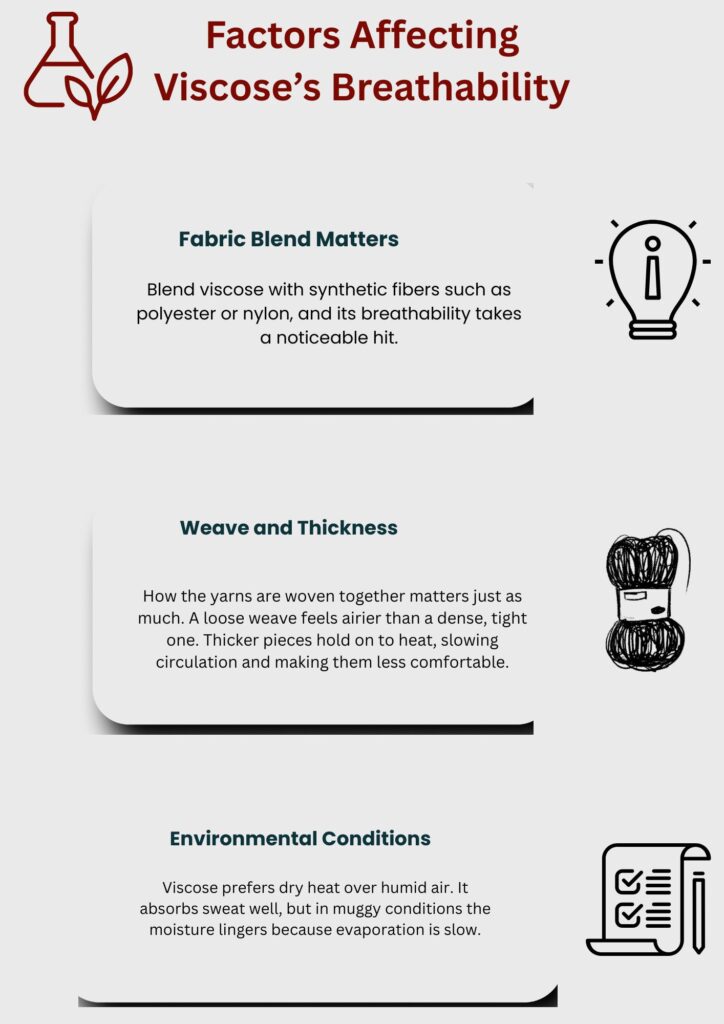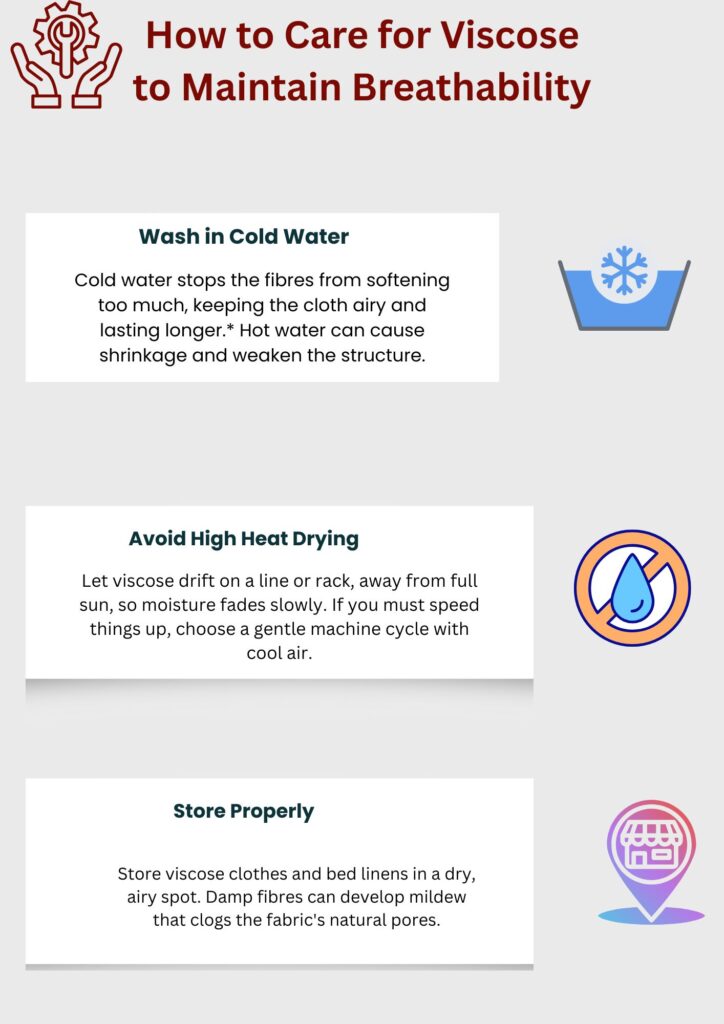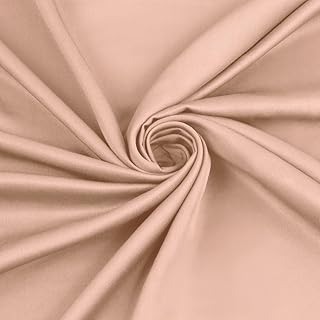Introduction
, often called rayon, is a semi-synthetic created from natural cellulose, usually wood pulp.Is viscose a breathable fabric? Its soft fell, silk-like sheen, and low cost make it a go-to option for designers and shoppers alike. You’ll find viscose in everything from easy summer dresses to drapey living-room curtains, a staple touch in wardrobes and homes around the globe.
viscose is breathable. When the weather warms, during workouts, or just on long everyday errands, air circulation can make or break comfort. This article digs into that question, stacking viscose next to cotton, polyester, linen, and bamboo to show how each fiber handles heat and humidity.
What Is Viscose Fabric?
Origin and Production Process
Viscose starts with cellulose, fibers pulled mainly from the pulp of beech, pine, or eucalyptus trees. After a chemical bath, the material becomes soft enough to spin into thread. Because this transformation is guided by people, experts call it a semi-synthetic fiber, even if its origin is plant-based.Vicose is breathable.That mix of natural source and lab work is what gives viscose its special feel. It combines the easy comfort of cotton with the lower cost usually tied to synthetic fabrics.
How Viscose Compares to Other Fabrics
Put alongside cotton or linen, viscose feels smoother and hangs with a dressier line. It gathers moisture comfortably, helping keep skin dry through a warm day. Unlike polyester, viscose lets some air slip through, so the stifling cling many synthetics have is toned down.
Key Characteristics of Viscose
Because of its gentle feel, wide-ranging colour options, and easy draping, viscose has built a loyal following among designers and shoppers alike. You find it in blouses, slips, skirts, and lounge wear where fluid movement and breathability matter most. Still, how a mill treats the fibre, and whether it is blended with other yarns, can swing the final performance significantly.
Is Viscose Breathable?
A Direct Answer to the Big Question
Yes, viscose breathes better than all the heavier synthetic fabrics, yet it still trails cotton and linen. Think of it as sitting in the middle of the comfort scale when airflow and moisture control are considered. That puts viscose in the daily-wear sweet spot for warm, dry places.
Reasons Why Viscose Offers Some Breathability
The fiber itself is light, and the way it is made leaves little passages that air can sneak through. It also drinks up sweat, so skin stays cooler and drier than it would with polyester or acrylic. While it will never beat pure-natural blends, viscose certain beats most budget blends.
In short, viscose offers a handy mix of comfort, low cost, and decent breathability-so long as the weather stays on its side.
Factors Affecting Viscose’s Breathability

1. Fabric Blend Matters
Blend viscose with synthetic fibers such as polyester or nylon, and its breathability takes a noticeable hit. A fabric that is 100 percent viscose works better in that regard. Mix in synthetics, and the airflow slows down, leaving moisture trapped inside.
2. Weave and Thickness
How the yarns are woven together matters just as much. A loose weave feels airier than a dense, tight one. Thicker pieces hold on to heat, slowing circulation and making them less comfortable.
3. Environmental Conditions
Viscose prefers dry heat over humid air. It absorbs sweat well, but in muggy conditions the moisture lingers because evaporation is slow. In tropical climates a cotton or linen blend is usually the smarter, breezier choice.
Viscose vs. Other Fabrics in Terms of Breathability
Viscose vs. Cotton
Lightweight, 100 percent cotton feels more breathable than viscose, because air moves through it easily and it dries fast. That quick drying and steady air flow make pure cotton a favorite for hot days or any activity likely to make you sweat.
Viscose vs. Linen
Among common fabrics, linen beats them all for breathability. Its wide, loose weave and natural moisture wicking fibers let heat escape almost freely. By comparison, viscose can start to feel a bit muggy in really humid air, even though it drapes nicely and feels plush against the skin.
Viscose vs. Polyester
People usually think of polyester as nearly airtight, and in that regard it is, so viscose usually comes out ahead. Viscose moves air better and lifts moisture away from the body more effectively. If the choice is simply polyester or viscose, stick with viscose for a more comfortable, breathable experience.
Viscose vs. Bamboo Viscose
Bamboo viscose comes straight from shredded bamboo pulp and is usually a bit airier than the standard viscose blend. It feels cooler to the touch and naturally pulls sweat away from the skin. Because of these features, bamboo viscose works well in hot weather and for people with more sensitive complexions.
Best Uses of Viscose for Breathability
Clothing: Dresses, Blouses, and Skirts
Regular viscose really shines in easy-breezy clothes like summer dresses, loose blouses, and gentle wrap skirts vicose is breathable.The lightweight drape adds a floaty look while still letting air move. That said, viscose performs best in warm but not oppressively humid conditions.
Home Textiles: Bedding and Loungewear
Bedding sets and lazy-day loungewear use viscose for its silky, almost silky-soft feel and fair breathability. It stays pleasantly cool against bare legs during warm nights or early-morning naps. Just steer clear of wearing or storing it in places that stay damp.
When to Avoid Viscose
Viscose isnt the best choice for serious training or days when you sweat a lot. It soaks up moisture but holds onto it, which can start to feel soggy after a while. For those sessions, stick with high-performance blends or good old cotton.
Pros and Cons of Viscose for Breathability
Pros
- Lightweight: Glides over skin and feels breezy.
- Soft Texture: Has that silky touch people appreciate.
- Moisture-Absorbing: Takes sweat away instead of letting it sit.
- Good Drape: Falls gently, letting air pass beside the body.
Cons
- Wrinkles Easily: If you dont iron or hang immediately, creases settle in and spoil the look.
- Reduced Airflow in Blends: Add polyester or nylon and the fabric stops breathing as well.
- Not Ideal in Humidity: Under the tropical sun it clings and feels a bit gummy.
How to Care for Viscose to Maintain Breathability

Wash in Cold Water
Cold water stops the fibres from softening too much, keeping the cloth airy and lasting longer.* Hot water can cause shrinkage and weaken the structure.
Avoid High-Heat Drying
Let viscose drift on a line or rack, away from full sun, so moisture fades slowly. If you must speed things up, choose a gentle machine cycle with cool air.
Store Properly
Store viscose clothes and bed linens in a dry, airy spot. Damp fibres can develop mildew that clogs the fabric’s natural pores. Always double-check that each piece is completely dry before putting it away to prevent any damage.
Common Misconceptions About Viscose Breathability
“Viscose Is as Breathable as Cotton” False
Although viscose is breathable, it still falls short of cotton. Cotton moves air and wicks away moisture better, especially in steamy weather vicose is breathable. For maximum comfort in humidity, choose cotton whenever possible.
“All Viscose Blends Are Equally Breathable” False
How breathable viscose really is depends a lot on what fiber it’s mixed with. Teaming it up with polyester, nylon, or acrylic cuts back on airflow. That’s why it’s smart to glance at the label before you buy.
“All Viscose Blends Are Equally Breathable” False
How breathable viscose really is depends a lot on what fiber it’s mixed with. Teaming it up with polyester, nylon, or acrylic cuts back on airflow. That’s why it’s smart to glance at the label before you buy.
“Viscose Wicks Sweat Like Performance Fabrics” False
Viscose soaks up moisture nicely, but it doesn’t pull sweat away fast. It can stay feeling damp longer, which is no fun if you’re moving around a lot.
Conclusion
It breathes better than pure polyester yet lags behind cotton or linen. In a dry room or hot desert day it feels light and airy; let the air get muggy and it starts to stick.
Pick viscose for laid-back weekends, office looks, or summer trips where softness counts most. Skip it for gym gear or any high energy outdoor sport. And if breathability is top of your list, look for pure viscose or bamboo viscose.
Treat it gently, hang it to dry, and this slinky fabric can be a chic, workhorse layer you’re glad to have.
FAQs
Yes, viscose is breathable, but it is not as breathable as cotton or linen. It allows for moderate airflow and moisture absorption, making it a comfortable option for mild to warm weather, especially in dry climates.
Cotton is more breathable than viscose. It allows for better airflow and moisture evaporation, making it more suitable for hot and humid conditions. Viscose is softer and has a silk-like texture but doesn’t perform as well in humidity.
Yes, viscose can be worn in hot weather. Its lightweight nature and ability to absorb moisture make it a good choice for casual summer outfits like dresses, skirts, and blouses. However, it may not perform well in high humidity.


